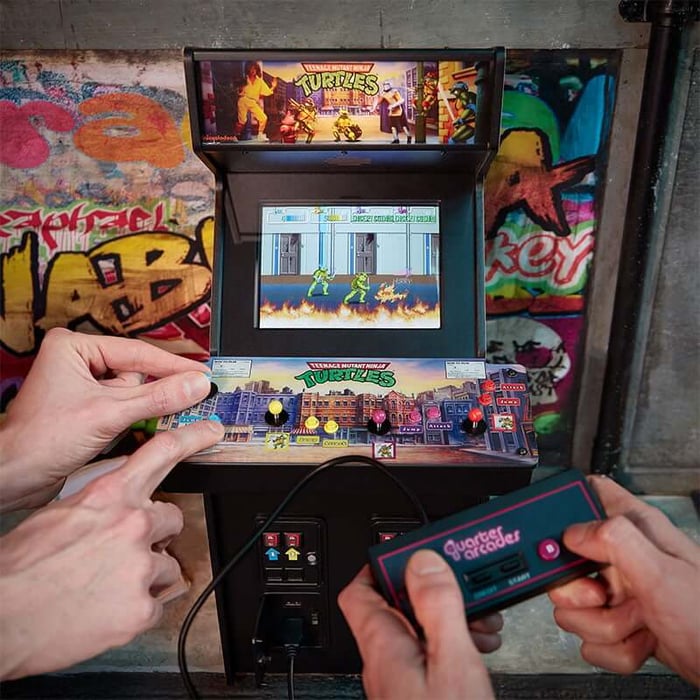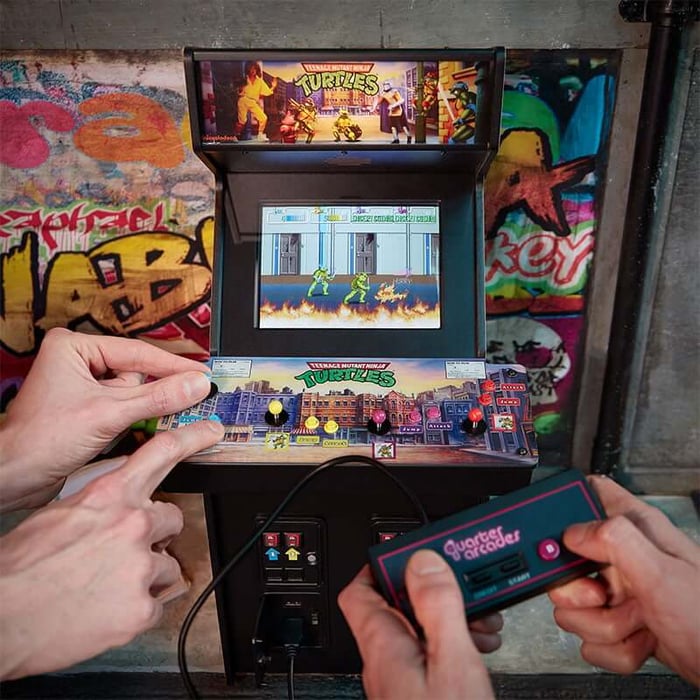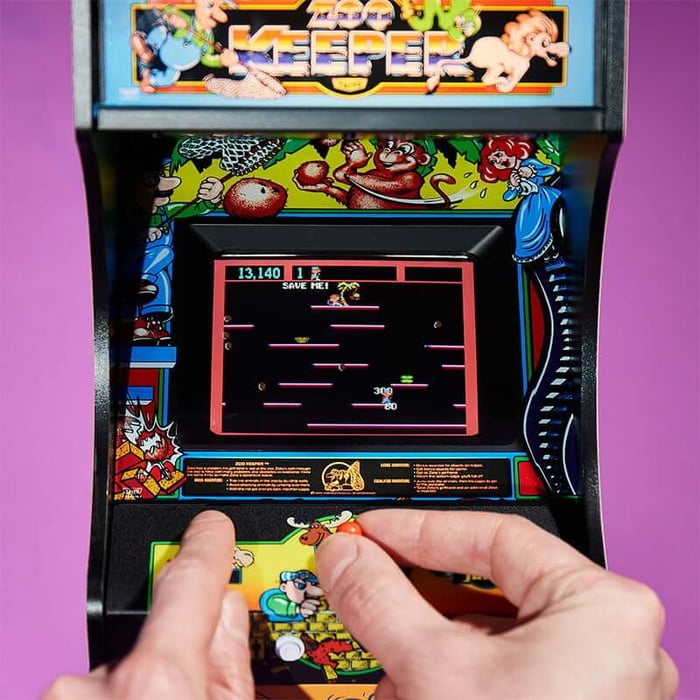Advancements in technology have drastically improved the visual quality of quarter-sized arcades, making them more engaging and realistic than ever before. Better display screens, enhanced lighting, and sharper graphics have transformed these small machines from simple pixelated games into vivid, immersive experiences.
These improvements let you enjoy clearer images and smoother animations, bringing classic arcade gameplay to life in a way that feels fresh.
These changes are not just about looks; they also affect how you interact with the game. With more detailed visuals, the games become more attractive and easier to understand, helping to keep your interest longer. As technology evolves, these quarter-sized arcades continue to blend nostalgia with modern design, making them appealing both to longtime fans and new players.
Key Takeaways
- Visual technology upgrades have made quarter-sized arcade games more detailed and immersive.
- Enhanced graphics improve player engagement and game clarity.
- Modern designs mix classic charm with up-to-date technology for wider appeal.
Technological Advances Transforming Quarter-Sized Arcades
Quarter-sized arcades have seen big changes in how they look and sound. Improvements in screens, audio systems, and smaller, more powerful internal parts have raised the quality of these compact machines.
This allows you to enjoy better visuals, clearer sound, and smoother gameplay from a device much smaller than older models.
Display Innovation and Pixel Clarity
You’ll notice that modern quarter-sized arcades use highly advanced display technology. LED and OLED screens provide brighter colours and sharper contrast than older LCDs or CRTs.
Pixel density has greatly increased, which means images appear crisper even on a small screen. This makes characters and game details easier to see.
Some devices now include anti-glare coatings and adjustable brightness controls. These features improve visibility under different lighting conditions, whether you are indoors or under strong daylight.
The higher refresh rates reduce flicker and motion blur, creating smoother animation. This upgrade makes fast-paced games more enjoyable on a compact arcade device.
Enhanced Audio and Sound Reproduction
Sound quality has also improved in these quarter-sized arcades. New audio chips and tiny speakers can now reproduce a wider range of sound frequencies.
You can experience clearer music, richer bass, and more distinct sound effects. This adds to the immersive feel of the game, even though the device is small.
Many modern machines use digital sound processing to reduce noise and distortion. Some even support headphone output for private listening.
This leap in audio tech means the gameplay experience is no longer limited by the size of the cabinet.
Miniaturisation of Internal Hardware
Advances in miniaturisation allow manufacturers to pack powerful components inside very small arcade units.
Microprocessors and memory chips have become smaller and more energy-efficient, letting you run complex games smoothly. This also reduces heat output, improving device reliability.
Storage is now mostly solid-state, which is quicker and less prone to damage than older formats. This helps your arcade run games faster without loading delays.
Smaller hardware means the device can be designed in more creative and portable shapes, making quarter-sized arcades both sturdy and easy to carry.
Key Improvements in Miniaturisation:
| Component Type | Change | Benefit |
|---|---|---|
| Processor | Smaller, faster chips | Improved game performance |
| Memory | Compact, low power consumption | Supports more complex games |
| Storage | Solid-state drives | Faster loading times |
| Cooling | Enhanced passive cooling | Device longevity |
Improvements in Visual Fidelity and Authenticity
The visual quality of quarter-sized arcades has advanced thanks to better screens, more accurate game software, and detailed cabinet designs. These changes make your experience closer to the original arcade feel while improving clarity and immersion.
Screen Quality and Backlighting
Modern arcade machines use higher resolution screens than the older CRTs. You’ll find LCD and OLED panels that provide sharper images and richer colours. These displays reduce flicker and improve brightness, making games easier to see in various lighting conditions.
Backlighting technology has also improved. LED backlights offer consistent illumination without the glare or dim spots common in older machines. This means the visuals stay clear and vibrant. Some arcade designs mimic the warm glow of original screens to keep the authentic look while improving performance.
Original Game ROM Integration
One key to visual authenticity is using the original game ROMs. Many arcade restorations now rely on these exact software files rather than newer, modified versions. You get the same graphics and animation as the original coin-operated machines.
Emulation software has improved to better replicate the original hardware’s visual output. This reduces glitches and visual distortions. The result is an experience where the game’s look and feel match what you played years ago, preserving the original design intent.
Cabinet Detailing and Aesthetics
The physical artwork and cabinet build remain crucial for authenticity. New machines pay close attention to replicating the colours, artwork, and textures on the cabinet surfaces.
Materials like textured plastics and painted finishes are chosen to match the originals. Cabinet lighting is recreated to highlight artwork without washing out colours. Controls and buttons are designed to look and respond like those in classic arcades, enhancing the overall visual and tactile experience.
User Experience and Accessibility Enhancements
Advancements in technology have improved the way you interact with quarter-sized arcades. Power options, control layouts, and design changes work together to make your experience smoother and more enjoyable. These upgrades also help with easy transport and convenient use.
Rechargeable Power Solutions
Many modern quarter-sized arcades use rechargeable batteries. This means you don’t need to buy new batteries constantly, saving you money and hassle. Rechargeable solutions often include USB-C ports, letting you plug in and recharge quickly from common chargers or power banks.
Some models offer long battery life, allowing you to play for hours without pausing. You can also see battery levels clearly, so you know when it’s time to recharge. This feature improves your overall shopping experience by making the product more convenient and dependable.
User Interface and Controls
Technology has made controls on these devices more user-friendly. Buttons and joysticks are now designed to respond better and last longer. They often match the feel of classic arcades but are made with modern materials that resist wear.
Screen brightness and touch responsiveness have also improved, helping in different lighting conditions. Clear menus and simple setups mean you spend less time figuring out how to use the device. These factors make your interaction smoother, which is crucial when you want quick fun or long play sessions.
Portability and Compact Design
Quarter-sized arcades have become lighter and smaller without losing durability. This compact design makes it easy to carry your device anywhere, whether in a bag or by hand. The reduced size means the arcade fits comfortably during travel or short trips.
Manufacturers focus on sturdy casing to protect your arcade while maintaining a sleek look. Some models include stands or grips to improve usability when playing on different surfaces. This focus on portability enhances your ability to enjoy games on the go or bring the arcade to social settings.
Frequently Asked Questions
Smaller arcade machines now use sharper screens and better chips, improving game visuals significantly. You will find technology from advanced display panels to powerful graphics processors, all working together to enhance your gaming experience.
What improvements have been made to display technology in compact arcade machines?
You can expect brighter, higher contrast LCD and OLED screens replacing older, bulky CRTs. This means clearer images and more vivid colours in a smaller form.
How has the miniaturisation of electronic components benefited the graphical capacity of small arcades?
Smaller parts allow more advanced circuits to fit inside a limited space. This lets your arcade machine handle complex graphics without needing a larger cabinet.
In what ways has the processing power of quarter-sized arcades evolved to enhance visual performance?
Modern compact arcades use faster microprocessors. This lets you enjoy smoother animations and quicker response times compared to earlier models.
What role has software development played in the visual enhancements of scaled-down arcade games?
Improved programming techniques optimise graphic rendering. You will see more detailed sprites and richer backgrounds even on limited hardware.
How have developments in graphics processing units (GPUs) impacted the visuals of modern compact arcade systems?
Compact arcade systems now include specialised GPUs. These handle shading and texture work, making game visuals more lifelike and engaging.
What advancements in screen resolution are apparent in the latest generation of small-scale arcade machines?
Latest models often feature HD or higher resolutions. This upgrade delivers sharper images and more precise visual details on your quarter-sized arcade screen.



















